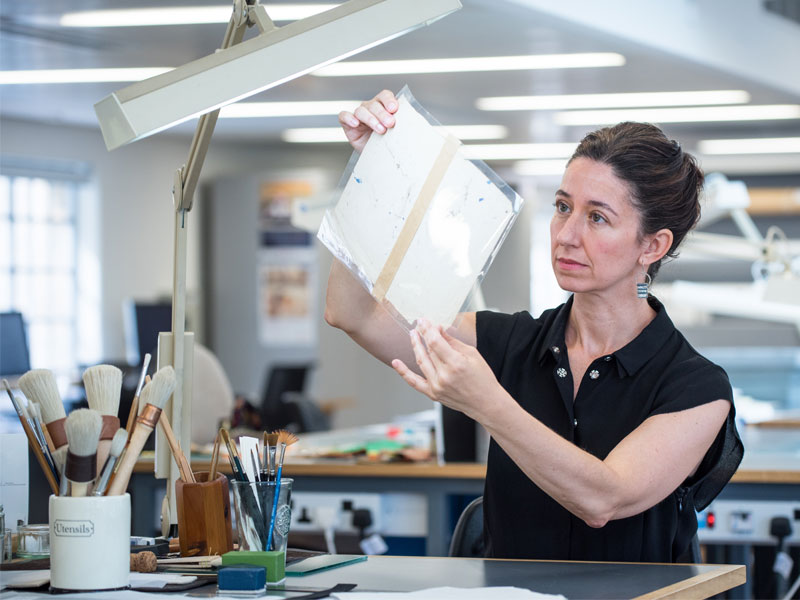'Our remit is global and beyond,’ explains Nick Millea, Map Librarian at the Bodleian. ‘We’ve got maps of planets, places that don’t exist; we’ve got all sorts.’
Nick looks after the Bodleian Libraries’ map collection – one of the world’s principal cartographic collections. Ranging in date from the fourteenth through to the twenty-first century, it contains roughly 1.25 million maps, 20,000 atlases and a rapidly growing digital collection. ‘Anything from material like the Gough Map, which is the earliest surviving map to show Britain in a geographically recognisable form, right through to items produced today on computer screens,’ he says. ‘If it’s got spatial information on it, then we’ll collect it.’
The Bodleian’s collections play a significant role in academic research, which can involve the use of existing maps held in the collection, as well as the creation of maps specific to an individual’s personal requirements. Students, for example, may need to generate bespoke maps on which to plot data collected in the course of their fieldwork.
As well as academic research, readers draw on the Bodleian’s map collections for a wide variety of other reasons. ‘You get people planning expeditions, authors working on their novels, people wanting to know the history of a site because they’d like to develop it. International boundary disputes are an interesting one too, as well as police forces working on cold crimes – the map room helped to crack a cold case in Coventry,’ he recalls. ‘Just one of those things you don’t expect.
‘Other things you probably don’t expect are great big tapestries hanging on the wall!’ says Nick. The Sheldon Tapestry Map of Worcestershire, to which he is referring, is one of four commissioned by landowner Ralph Sheldon in the 1590s to decorate his newly built house at Weston, in south Warwickshire. It was bequeathed to the Bodleian in the early nineteenth century by antiquary Richard Gough, along with a companion tapestry illustrating Oxfordshire. A third, depicting Gloucestershire, was purchased by the Bodleian at auction in 2007, following a successful fundraising campaign.
The enthusiasm that the Sheldon Tapestry Map has created has been a joy to behold.Nick Millea
Sheldon’s tapestries were groundbreaking at the time of their creation, however ‘from 1809, nobody really saw the Worcestershire tapestry again until 2012,’ says Nick. It wasn’t until work began on the Weston Library, and ‘we realised that we would have this big wall in the Blackwell Hall – the perfect size to display a tapestry on – that everything started to fall into place.’
The Bodleian embarked upon a cutting-edge programme of treatment, analysis and research that would bring together teams from across the library, as well as academics and scientists from institutions around the world. ‘We formed a pool of experts that could help us in finding the most appropriate approach to scientific analysis,’ explains Virginia Lladó-Buisán, Head of the Bodleian’s Conservation and Collection Care team.
While the tapestry underwent a process of delicate hand stitching at the National Trust’s textile workshop in Norfolk, back in Oxford work began to identify its provenance. ‘We analysed the dyes present in the tapestry, which has taken us a step closer to answering some of our scholarly questions,’ says Virginia. ‘Next, we want to ascertain the origin of the wool used to make the tapestries, which could potentially give an indication of the provenance.’

Although the map is now on show, the Bodleian’s work is far from over. The Worcestershire tapestry will continue to be monitored during its display, and conservation work will soon start on the Oxfordshire and Gloucestershire maps. Nick and Virginia are also planning an international conference for 2017 focusing on the study and conservation of historic tapestries. ‘We’re hoping to live-stream it,’ explains Virginia, ‘to make sure that we are able to share the work we’ve done with the wider public. They’re very important tapestries.’
To the Bodleian, sharing research, knowledge and collections in this way is of paramount importance. ‘My role is to make sure that we reach out and communicate the work we do,’ says Virginia. ‘We teach people, we give lectures, we organise conferences, we provide training courses such as book binding, and we’re on social media. We’re an academic-related team, but we want to engage with people at all levels.’
To have been involved with this project has been an enormous privilege, and given me enormous satisfaction as a conservator.Virginia Lladó-Buisán
Nick echoes this sentiment: ‘Such is the demand for information that we send somebody from our team down to the Worcestershire tapestry each morning to tell the public about it and answer questions. That’s all part of being in the Weston Library; all of a sudden people are coming in and they love what they can see, and we’re telling people “Look, we’ve got this!” The fact that we now have a glass door instead of a brick wall, and can say “come in”, well, it’s just terrific.’
Preserving and disseminating knowledge in this way would not be possible without the support of donors, whether helping the Bodleian to acquire maps of historical importance or funding their subsequent conservation and research. Donors to the conservation of the Sheldon map included The Clothworkers’ Foundation, Lady Elizabeth Marriner, the J Paul Getty Jnr Charitable Trust and the Drapers’ Charitable Fund.
‘It’s been a very expensive project, and still is,’ says Nick. ‘We couldn’t have done it without philanthropy – it’s just great to know that there are people out there who have an interest in maps, and feel as passionately about them as we do.’
The Bodleian’s map holdings are also part of its endowment campaign, which aims to secure, preserve and enhance the Bodleian Libraries’ unique resources for the benefit of future generations.